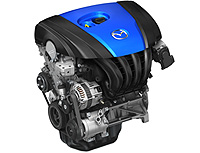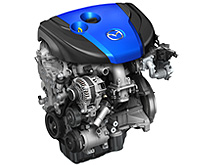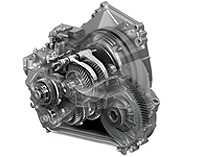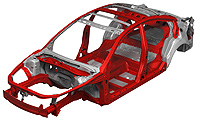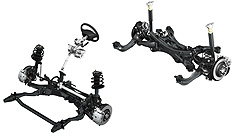Schaeffler Improves Stop/Start for Auto Transmissions
By Tom Murphy
WardsAuto.com, Jun 3, 2011 9:00 AM
TROY, MI – A small percentage of American drivers have become accustomed to stop/start systems by virtue of their placement on hybrid-electric vehicles, which now make up about 2.5% of U.S. light vehicles, according to Ward’s data.
But stop/start systems soon will get a major boost with the arrival of mild hybrids from several auto makers as they adjust their fleets to meet new fuel-economy mandates by 2016.
Some 10 million stop/start systems are expected to be on the road worldwide by 2015, according to some estimates.
Germany’s Schaeffler Group, a leading supplier of torque converters, has a new approach that simplifies integration of stop/start systems in conventional vehicles equipped with automatic transmissions, which are enormously popular in the U.S.
An automatic transmission makes it more difficult to incorporate stop/start because the torque converter between the engine and transmission is always engaged.

But Schaeffler has designed a permanently engaged starter that turns the torque converter into a useful weapon in reducing fuel consumption by allowing stop/start to function seamlessly – and cost-effectively – with automatic transmissions.
The system uses a 1-way clutch between the engine crankshaft and the torque converter’s starter ring gear that allows the mesh between the ring gear and the starter motor pinion to remain constant. Once the engine stops, restarts are immediate, Schaeffler says.
Eliminating slow response at restart and accommodating “change of mind” driving situations were chief objectives as the supplier developed the permanently engaged starter, says Jeff Hemphill, Schaeffler Group USA’s vice president-product development for LuK USA and region director-technical product development.
A conventional automatic mated to a stop/start system will be slow to respond, he says. When a driver is approaching a traffic light that is red, he takes his foot off the gas and the engine prepares to shut down as the vehicle coasts.
When the light turns green and the vehicle is still moving, the driver switches from the brake to the gas, but the engine is still rotating, preparing to shut down.
“If you have just a normal starter, you would have to wait until you get to zero, and then you’d get a few bumps. At zero, the engine can start cranking again,” Hemphill says.
This unsettling pause and abrupt restart drew criticism from consumers when the first hybrids arrived in the 1990s with continuously variable transmissions.
Since then, full hybrids have gotten much better. But integrating stop/start with automatic transmissions using conventional torque converters will create a pause of up to 3 seconds during those “change of mind” driving situations, Hemphill says.
“Can you imagine if you’re a driver at a green traffic light with your foot on the gas waiting for a count of three before something happens?” he says. “That’s not a very acceptable condition.”
Automatic transmissions operate with an oil pump that is driven by the engine. When the engine shuts down, so does the transmission. To avoid that awkward pause with a stop/start system, auto makers have few affordable options.
Schaeffler’s permanently engaged starter, as the name implies, can reconnect while the engine is still rotating and the vehicle is decelerating. The starter can be engaged at any time without the need to synchronize ring gear and pinion speeds prior to engagement.
The restart “happens silently because it’s a friction connection, not a gear-tooth trying to engage,” Hemphill says. “It can quickly re-engage and restart and recrank the engine silently.”
Hemphill is aware of only Toyota using a permanently engaged starter, which is lubricated by engine oil and requires additional seals and a modified engine block.
Schaeffler’s device is dry, which means no oil galleys or seals are necessary and engine-block changes are minor.
Integrating the permanently engaged starter doesn’t require changes to the bell housing or other major structures but needs about 0.19 ins. (5 mm) of extra space, which might require reconfiguring the torque converter.
Hemphill declines to discuss cost of the unit but says stop/start technology needs to be available to auto makers for about $100 per vehicle.
“We can’t guarantee that we’re going to meet that target, but we think we’re on the right road,” he says.
Hemphill considers Schaeffler’s technology “a value proposition” compared with other approaches being pursued or already in the market.
“They have electric-driven pumps or accumulators where you have to do more tear-up of the transmission hydraulics to patch that stuff in, and the devices themselves are fairly expensive,” he says. “I would think it’s much more than $100 per vehicle.”
The permanently engaged starter is well-suited for torque-converter applications, but the basic principle also works with manual transmissions, in which case the device would mount to a flywheel instead of a flex plate with an automatic.
“We’re developing it now for a couple manual applications in Europe, so it has advantages there as well,” Hemphill says. A prototype currently is in development for a diesel engine application, he says.
Stop/start systems are appearing across a wide range of vehicles, including the high-powered BMW M3 and Porsche Cayenne and Panamera and, for the ’12 model year, the Mercedes AMG editions of the CL63, CLS63, E63 and S63.
European auto makers have taken the lead in introducing stop/start systems because the technology can be applied easily to manual transmissions, which are popular in Europe.
With a manual transmission, a stop/start system can reduce fuel consumption between 2% and 5% in city driving, while an automatic transmission with stop/start can boost efficiency between 4% and 8% in the city, Hemphill says.
In Europe and the U.S., about 20% of city driving is spent standing still at stop lights; the percentage is much higher in Japan.
More than 30% of new vehicles in Europe are employing stop/start in 2011, Schaeffler says.
Robert Bosch says it expects that penetration rate to reach 50% by 2013. The supplier expects to double its worldwide sales of stop/start systems from 1.3 million units in 2010 to 2.6 million this year.
In the U.S., the ’12 Buick LaCrosse with eAssist arrives this summer with a conventional 6-speed automatic transmission and a stop/start system augmented by a 115V lithium-ion battery pack to provide additional torque.
With its hybrid-electric component, Hemphill says GM’s eAssist is more capable than Schaeffler’s permanently engaged starter solution, which he considers a more affordable approach aimed at higher volumes.
Ford has announced it will add stop/start technology to all of its North American vehicles equipped with its direct-injection turbocharged EcoBoost engines.
Kia also is introducing stop/start on its Rio subcompact.
tmurphy@wardsauto.com
Original article available here: http://wardsauto.com/ar/schaeffler_improves_auto_110603/

